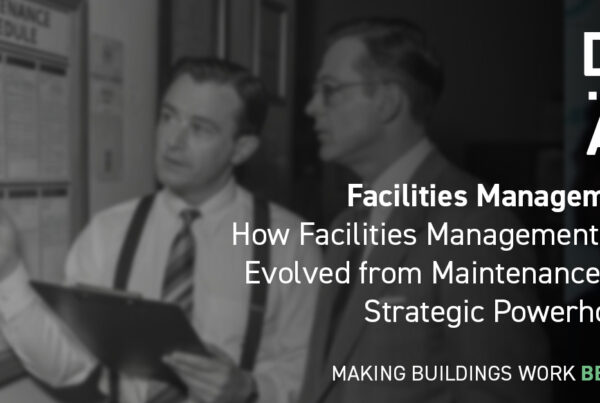
What a Stabilising Economy Means for Efficiency, Compliance, and Sustainability in the Built Environment
How inflation, interest rates and government investment are shaping facilities management strategies in 2025
The year 2025 brings a new chapter in the UK’s economic story, one defined by cautious optimism and the promise of stability. After years of navigating uncertainty, from global pandemics to energy crises, businesses across the country are beginning to find firmer ground. For the facilities management (FM) sector, this shift presents both opportunities and challenges. As inflation cools and interest rates fall, the industry is being asked to adapt once again, but this time to a market where long-term value, efficiency and sustainability take centre stage.
This article explores how the evolving economic landscape is influencing FM strategies and market performance. With forecasts from CBRE and Frost & Sullivan, alongside insights from industry leaders and examples from public sector partnerships, we look at how FM providers are recalibrating their approaches to meet customer needs and seize new growth opportunities.
A Look at the 2025 Economic Landscape
CBRE’s UK Real Estate Market Outlook 2025 outlines a more stable macroeconomic environment. The report anticipates inflation to remain close to the Bank of England’s target, and projects a base rate cut of 100 basis points. Combined, these trends are expected to stimulate the economy, with a forecasted GDP growth of 1.8 percent.
This sense of balance is a welcome change for FM providers, who have weathered years of reactive decision-making by customers. However, the landscape is not without complications. One area flagged is the government’s shift in National Insurance Contributions (NICs), which could inadvertently raise labour costs and place pressure on job creation. While economic growth is expected, this additional burden may hit service sectors such as FM especially hard, where a large workforce is essential.
Measuring Market Performance and Trends
The UK’s outsourced facilities management market has shown notable resilience and evolution since the COVID-19 pandemic reshaped working environments and service expectations. According to Frost & Sullivan, the industry experienced a strong rebound in revenue growth following the disruptions of 2021 and is now forecast to grow at a compound annual growth rate (CAGR) of 3.0 percent through to 2030.
“While inflation will continue driving revenue expansion, it is forcing up costs and pressuring service providers’ margins.”
— Frost & Sullivan, UK Facility Management Market Report
This deceleration should not be viewed negatively. Rather, it signals a shift toward maturity. Customers are no longer reacting to emergencies. Instead, they are beginning to prioritise efficiency, predictability and sustainability. As a result, FM providers must evolve from being problem solvers to strategic partners.
Strategic Shifts in Facilities Management Approaches
The new economic landscape is transforming how FM companies deliver services. Cost control remains a dominant theme, but it now takes a more sophisticated form. Customers are demanding transparency in pricing, clear return on investment, and data-driven performance reporting.
Steve McGregor, Executive Chairman of DMA Group, summarises this evolution:
“In this climate, FM providers must go beyond simply managing their own operational costs. They are now expected to take an active role in helping customers navigate economic pressures as well, offering not just services, but strategic insights, measurable value, and innovative solutions that improve efficiency and reduce total cost of ownership. It is no longer enough to maintain buildings. Customers want partners who understand their challenges, optimise their environments, and directly contribute to financial and operational resilience.”
At the same time, changes to employment costs, particularly through NIC increases, are prompting providers to reassess their workforce strategies. Many are adopting new technologies to reduce dependence on manual labour, including remote monitoring systems and automated maintenance alerts. Others are focusing on staff development to move teams into more skilled, client-facing roles.
Sustainability is also a critical priority. Environmental, Social and Governance (ESG) criteria now influence procurement decisions across public and private sectors. FM companies are being asked to support customers in reducing carbon footprints, managing energy consumption, and achieving compliance with new environmental regulations.
For example, DMA Group’s energy and sustainability services have become a central part of its customer offering, helping organisations meet their environmental targets and operate more efficiently. By delivering tailored strategies and maintaining systems for optimum performance, DMA ensures that buildings run as energy-efficiently as possible while remaining compliant with evolving regulations. The team has been instrumental in large-scale sustainability projects, including the transformation of Rye, Winchelsea and District Memorial Hospital, which became the UK’s first carbon-neutral community hospital, a milestone achievement that demonstrates the impact of integrated energy and facilities management.
Impacts Across Key Sectors
The influence of economic stability is being felt differently across industries.
In the education and public sector, government investment is expected to create new opportunities, particularly as schools and trusts seek cost-effective ways to improve building performance. Multi Academy Trusts (MATs), in particular, are looking for FM partners who can manage both compliance and cost within increasingly tight budgets.
In healthcare, the push to reduce NHS backlogs is driving infrastructure upgrades and increased emphasis on safety and compliance. FM providers must ensure service continuity while meeting stricter energy performance targets and hygiene standards. The demand here is for reliability, round-the-clock monitoring and innovation.
Meanwhile, the commercial real estate sector continues to grapple with the effects of hybrid working. Landlords are seeking flexible, technology-led FM solutions that help retain tenants, optimise space usage and support ESG goals. Smart buildings, digital access controls, and responsive maintenance have moved from future features to immediate requirements.
Risks and Rewards for Facilities Management Providers
The road ahead is paved with opportunity but also laced with risk.
On the upside, FM companies are well positioned to win long-term contracts as customers seek partners they can rely on through both stable and uncertain times. The growing interest in environmental services also offers a chance to diversify revenue streams by introducing consultancy services and digital innovations.
However, rising labour and material costs continue to pressure margins. Delays in public-sector project delivery and increased competition, particularly from tech-savvy newcomers, are challenging traditional players to innovate quickly or risk falling behind.
Valerie Miller, Chief Customer Officer at DMA Group, stresses the importance of forward thinking:
“Facilities management is no longer just about keeping buildings operational. It has evolved into a strategic discipline that directly influences how organisations perform and grow. Today, customers expect more than reactive maintenance, they want insight, innovation and measurable impact. Whether it’s improving energy efficiency, ensuring compliance, or creating environments that support productivity and wellbeing, FM providers must show how their services align with broader organisational goals. It’s about delivering value, not just service, and proving that facilities management is a driver of performance, not a background function.”
Responding with Agility and Purpose
For FM leaders, the message is clear. This is the time to act with intention. Investment in digital tools like BiO®, DMA Group’s multi-award winning and transformational workforce management system, will be essential to manage compliance, cost and carbon all in one place.
At the same time, service models must evolve to offer greater flexibility. Customers are demanding tailored solutions, scalable delivery and advice that helps them achieve more with less.
Perhaps most importantly, FM providers must reposition themselves not as service vendors, but as strategic enablers. By helping customers navigate this period of economic adjustment, they can secure stronger relationships and deliver more meaningful outcomes.
Final Thoughts
While 2025 may not bring dramatic expansion for the FM sector, it marks a turning point. The return of economic stability invites a more deliberate and strategic approach to facilities management. FM providers who can respond with agility, invest in the right tools and offer true partnership will be the ones to watch.
For organisations looking to reduce risk, control costs and achieve sustainability goals, choosing the right FM partner has never been more important. The question is no longer whether FM is necessary, it is who can deliver it best.



